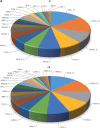Comprehensive characterization of CRC with germline mutations reveals a distinct somatic mutational landscape and elevated cancer risk in the Chinese population
- PMID: 35014770
- PMCID: PMC9196063
- DOI: 10.20892/j.issn.2095-3941.2021.0190
Comprehensive characterization of CRC with germline mutations reveals a distinct somatic mutational landscape and elevated cancer risk in the Chinese population
Abstract
Objective: Hereditary colorectal cancer (CRC) accounts for approximately 5%-10% of all CRC cases. The full profile of CRC-related germline mutations and the corresponding somatic mutational profile have not been fully determined in the Chinese population.
Methods: We performed the first population study investigating the germline mutation status in more than 1,000 (n = 1,923) Chinese patients with CRC and examined their relationship with the somatic mutational landscape. Germline alterations were examined with a 58-gene next-generation sequencing panel, and somatic alterations were examined with a 605-gene panel.
Results: A total of 92 pathogenic (P) mutations were identified in 85 patients, and 81 likely pathogenic (LP) germline mutations were identified in 62 patients, accounting for 7.6% (147/1,923) of all patients. MSH2 and APC was the most mutated gene in the Lynch syndrome and non-Lynch syndrome groups, respectively. Patients with P/LP mutations had a significantly higher ratio of microsatellite instability, highly deficient mismatch repair, family history of CRC, and lower age. The somatic mutational landscape revealed a significantly higher mutational frequency in the P group and a trend toward higher copy number variations in the non-P group. The Lynch syndrome group had a significantly higher mutational frequency and tumor mutational burden than the non-Lynch syndrome group. Clustering analysis revealed that the Notch signaling pathway was uniquely clustered in the Lynch syndrome group, and the MAPK and cAMP signaling pathways were uniquely clustered in the non-Lynch syndrome group. Population risk analysis indicated that the overall odds ratio was 11.13 (95% CI: 8.289-15.44) for the P group and 20.68 (95% CI: 12.89-33.18) for the LP group.
Conclusions: Distinct features were revealed in Chinese patients with CRC with germline mutations. The Notch signaling pathway was uniquely clustered in the Lynch syndrome group, and the MAPK and cAMP signaling pathways were uniquely clustered in the non-Lynch syndrome group. Patients with P/LP germline mutations exhibited higher CRC risk.
Keywords: Colorectal cancer; Lynch syndrome; MMR; MSI; Notch signaling pathway; TMB; germline; hereditary cancer; next-generation sequencing.
Copyright © 2022 Cancer Biology & Medicine.
Conflict of interest statement
Jianfei Yao, Pan Yang, Xiaohui Wang, Danni Liu, Tanxiao Huang, Huiya Cao, Peisu Suo, and Lele Song are employees of HaploX Biotechnology, and performed the NGS sequencing in this study. The other authors claim no conflicts of interest.
Figures










Similar articles
-
Second malignancies in patients with deficient mismatch repair system/microsatellite instability-high colorectal cancer.Therap Adv Gastroenterol. 2025 Jun 21;18:17562848251347375. doi: 10.1177/17562848251347375. eCollection 2025. Therap Adv Gastroenterol. 2025. PMID: 40547253 Free PMC article.
-
Genetic characterization of Lynch syndrome germline variants in a LATAM cohort using a customized NGS gene panel.Front Oncol. 2025 Aug 1;15:1589765. doi: 10.3389/fonc.2025.1589765. eCollection 2025. Front Oncol. 2025. PMID: 40823072 Free PMC article.
-
Comprehensive molecular assessment of mismatch repair deficiency in Lynch associated ovarian cancers using next generation sequencing panel.Int J Gynecol Cancer. 2024 Feb 5;34(2):267-276. doi: 10.1136/ijgc-2023-004815. Int J Gynecol Cancer. 2024. PMID: 37940339
-
Molecular testing for Lynch syndrome in people with colorectal cancer: systematic reviews and economic evaluation.Health Technol Assess. 2017 Sep;21(51):1-238. doi: 10.3310/hta21510. Health Technol Assess. 2017. PMID: 28895526 Free PMC article.
-
Lynch Syndrome.2004 Feb 5 [updated 2021 Feb 4]. In: Adam MP, Feldman J, Mirzaa GM, Pagon RA, Wallace SE, Amemiya A, editors. GeneReviews® [Internet]. Seattle (WA): University of Washington, Seattle; 1993–2025. 2004 Feb 5 [updated 2021 Feb 4]. In: Adam MP, Feldman J, Mirzaa GM, Pagon RA, Wallace SE, Amemiya A, editors. GeneReviews® [Internet]. Seattle (WA): University of Washington, Seattle; 1993–2025. PMID: 20301390 Free Books & Documents. Review.
Cited by
-
Comprehensive Multiomics Analyses Establish the Optimal Prognostic Model for Resectable Gastric Cancer : Prognosis Prediction for Resectable GC.Ann Surg Oncol. 2024 Mar;31(3):2078-2089. doi: 10.1245/s10434-023-14249-x. Epub 2023 Nov 23. Ann Surg Oncol. 2024. PMID: 37996637
-
Mutations of BRCA1, BRCA2, and PALB2 Genes in Breast Tumor Tissue: Relationship with the Effectiveness of Neoadjuvant Chemotherapy and Disease Prognosis.Genes (Basel). 2023 Jul 28;14(8):1554. doi: 10.3390/genes14081554. Genes (Basel). 2023. PMID: 37628606 Free PMC article.
-
Genetic polymorphisms in genes regulating cell death and prognosis of patients with rectal cancer receiving postoperative chemoradiotherapy.Cancer Biol Med. 2023 May 4;20(4):297-316. doi: 10.20892/j.issn.2095-3941.2022.0711. Cancer Biol Med. 2023. PMID: 37144561 Free PMC article.
-
CSCO guidelines for metastatic colorectal cancer: personalized medicine in clinical practice.Cancer Biol Med. 2023 Sep 9;20(9):640-5. doi: 10.20892/j.issn.2095-3941.2023.0211. Cancer Biol Med. 2023. PMID: 37700433 Free PMC article. No abstract available.
References
-
- Schreuders EH, Ruco A, Rabeneck L, Schoen RE, Sung JJ, Young GP, et al. Colorectal cancer screening: a global overview of existing programmes. Gut. 2015;64:1637–49. - PubMed
-
- Chen W, Zheng R, Baade PD, Zhang S, Zeng H, Bray F, et al. Cancer statistics in China, 2015. CA Cancer J Clin. 2016;66:115–32. - PubMed
-
- Lichtenstein P, Holm NV, Verkasalo PK, Iliadou A, Kaprio J, Koskenvuo M, et al. Environmental and heritable factors in the causation of cancer – analyses of cohorts of twins from Sweden, Denmark, and Finland. N Engl J Med. 2000;343:78–85. - PubMed
-
- Valle L. Recent discoveries in the genetics of familial colorectal cancer and polyposis. Clin Gastroenterol Hepatol. 2017;15:809–19. - PubMed
-
- Lorans M, Dow E, Macrae FA, Winship IM, Buchanan DD. Update on hereditary colorectal cancer: improving the clinical utility of multigene panel testing. Clin Colorectal Cancer. 2018;17:e293–305. - PubMed
Grants and funding
- 20170922151538732/Special Funds for Strategic Emerging Industry Development of Shenzhen
- JSGG20180703164202084/Science and Technology Project of Shenzhen
- 71573022/Natural Science Foundation Project of China
- 82060440/National Natural Science Foundation Regional Projects
- NLBJ-2019003/Chinese PLA General Hospital
LinkOut - more resources
Full Text Sources
Research Materials
